 It's a perfect moment for a bit of inquieti reflection.  
We said we'd get back to Italian illustrator Enzo Nistri, so today we have two posters he painted to promote the drama Sensi inquieti, which premiered in Italy today in 1962. It was originally made in France as Climats, and was known in English as Climates of Love. It starred Marina Vlady, Jean-Pierre Marielle, Emmanuele Riva, and Alexandra Stewart, and is about a married couple tempted to stray when their relationship begins to feel too constraining. It doesn't sound like our thing, so it isn't one we'll watch, but we thought these were particularly nice pieces. We also have the original art without text below, and a zoom so you can see some details of the work. Nistri was a top talent. We'll have more from him later.
 
 Who'd want to kill a child? On occasion, virtually any parent on the planet, but in this case it's a violent psychopath. 
This poster was painted by the great Enzo Nistri (the brush behind classic promos such as this and this) for the giallo flick Chi l'ha vista morire?, known in English as Who Saw Her Die? It stars former James Bond lead George Lazenby (looking unhealthily thin here because for reasons inexplicable he lost thirty-five pounds for the role) as an American artist in Venice whose young daughter goes missing. He first appeals to the (pro forma ineffectual) police, but the girl turns up floating dead in the Grand Canal.
This brings Lazenby's estranged wife Anita Strindberg to town for the funeral, and soon they're asking questions about a child murder from the previous year, which we the viewers have seen in the opening reel being committed by a woman clad and veiled in black. Lazenby and Strindberg go full sleuth in order to identify and locate this suspected killer, who meanwhile graduates to knocking off adults who might have clues. You may assume co-star and former Bond villain Adolfo Celi has something to do with all this, and he might, but this is a giallo. There's no way to know who's the killer until the final reveal.
The movie's real star may be Venice, where residents once sauntered easily through lanes uncluttered by tour groups and AirBnB renters. You'll see many hidden nooks of the city, beautifully shot by director Aldo Lado and cinematographer Franco Di Giacomo. This type of scenery will come courtesy of AI image generators in the approaching years. After all, why close down St. Mark's Square when you can render it in a computer? Take heart, though—even a computer will never be able to generate Anita Strindberg. Chi l'ha vista morire? premiered in Italy today in 1972.
 Life there is an ongoing domestic disturbance. 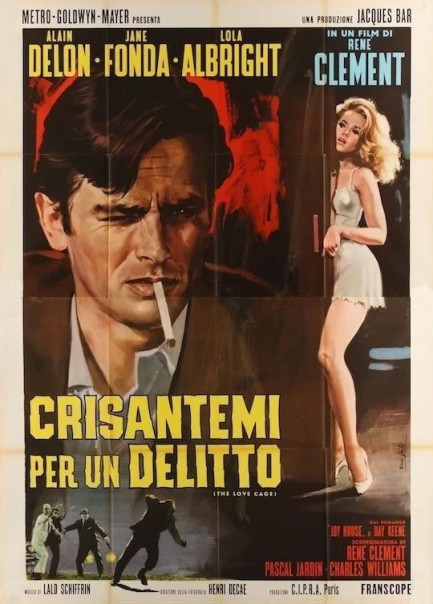 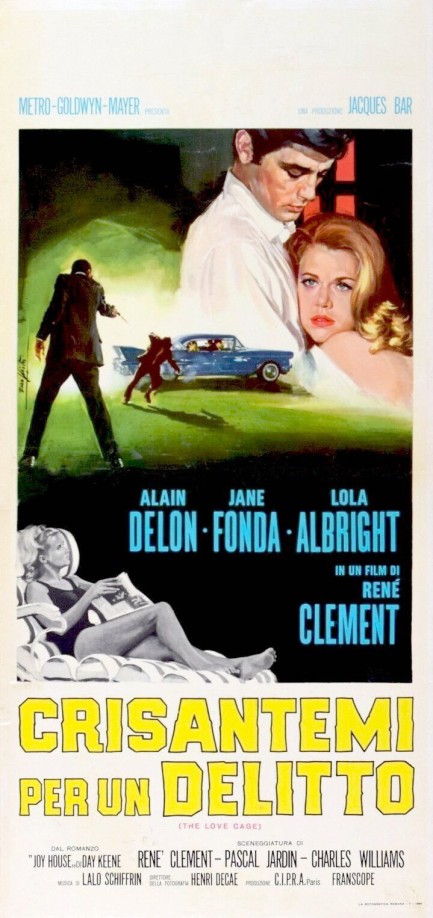
The posters you see here were made for the French thriller Les félins. While the French posters are fine, we thought these Italian promos were a bit more interesting. The first two were painted by Enzo Nistri, the second two by Sandro Symeoni. The movie was called Crisantemi per un delitto in Italy—“chrysanthemums for a crime.” No idea why. But fine, it's lyrical, which is never bad. It's based on the imaginative Day Keene novel Joy House, which is the title the movie retained for its U.S. run. In the book a derelict is plucked from a Chicago homeless shelter by a rich widow who needs a chauffeur, but her benevolence seems likely to backfire because her new driver was in the shelter only because it offered a perfect hiding place from mobsters seeking to kill him. But she has her own secret plans, and they're as sinister as they come. Working from a screenplay co-written by director René Clément and crime author Charles Williams, the movie slightly alters the approach of Keene's book. With Lola Albright playing the widow and Alain Delon as the hunted man, the story is transplanted from urban Chicago to the Côte d'Azur. Pre-Barbarella Jane Fonda features in a co-starring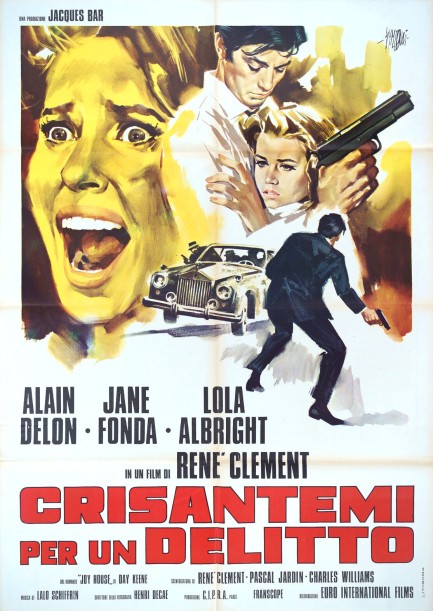 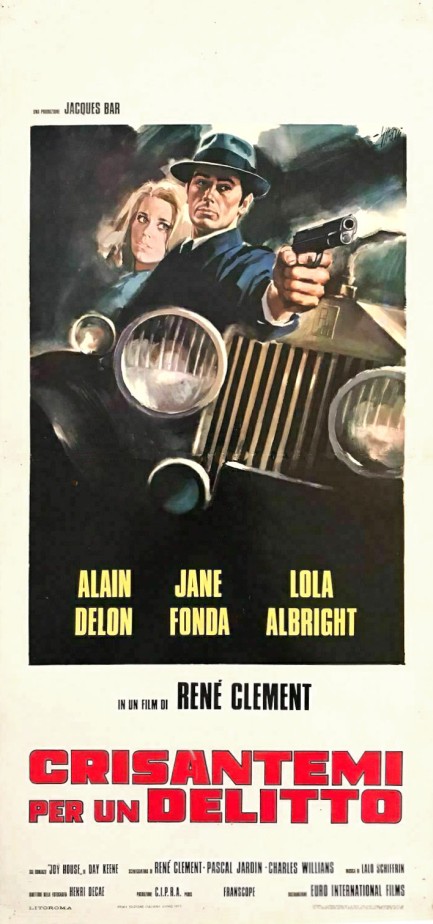 role as Albright's cousin and household helper. The two are soon in competition for Delon's affections, though he never forgets that his main goal is to escape the mobsters. While the general thrust of the plot remains a mystery as in Keene's novel, there's a heavy dose of action too, with excellent stunts. The ending differs as well. role as Albright's cousin and household helper. The two are soon in competition for Delon's affections, though he never forgets that his main goal is to escape the mobsters. While the general thrust of the plot remains a mystery as in Keene's novel, there's a heavy dose of action too, with excellent stunts. The ending differs as well.
The result is good, but also an example of both the highs and lows of French cinema of the period. Delon, Fonda, and Albright are decent actors bestowed a good script, and are all gorgeous and charismatic, but the movie spends a lot of time being cute. Even so, Clément and company pull it all together. Make sure you appreciate the production design, especially the Rolls Royce that Delon drives, with its completely transparent roof, c-pillars all. It's something we never knew existed. To us it looked like a good way to get heatstroke, but we guess it was made for rich occupants to see and be seen. We think Joy House should be seen. It premiered in France in June 1964, then opened at the Taormina Film Fest in Italy today the same year.
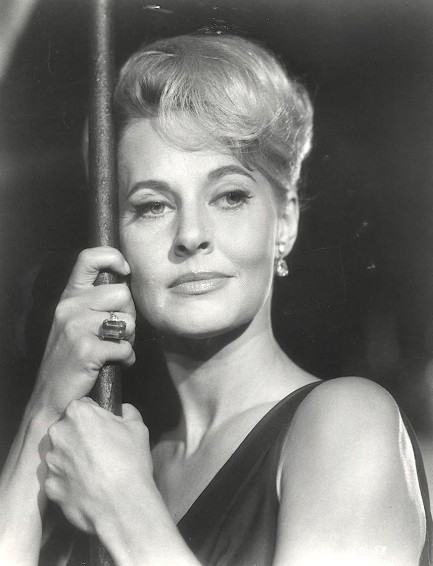 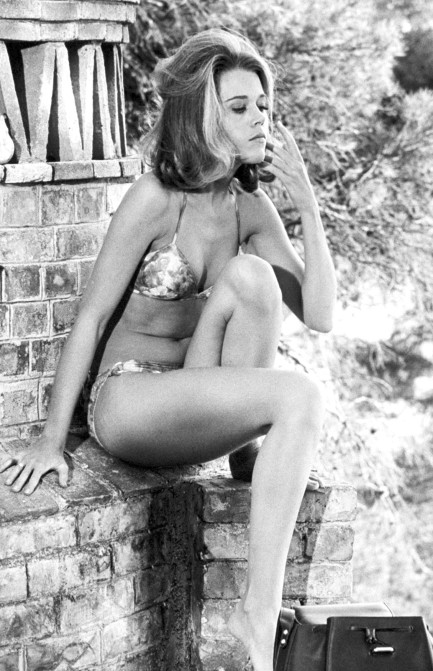 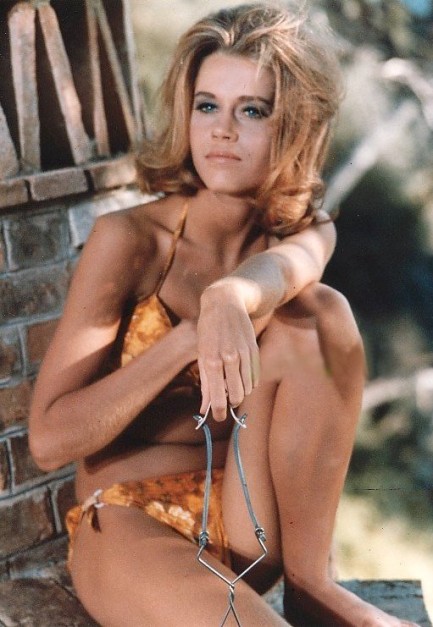 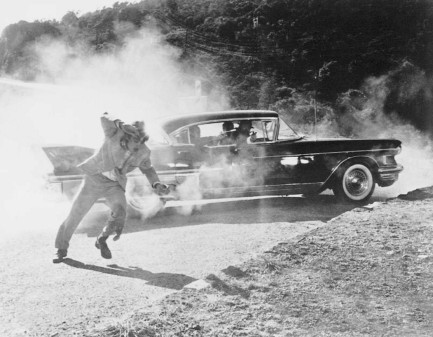 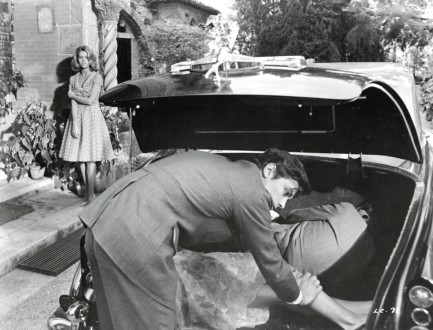 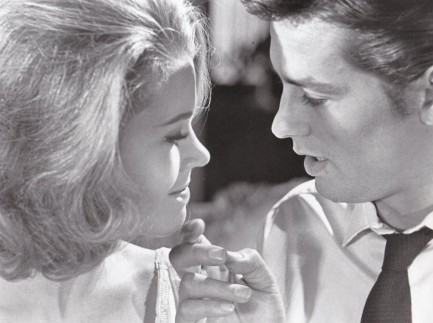 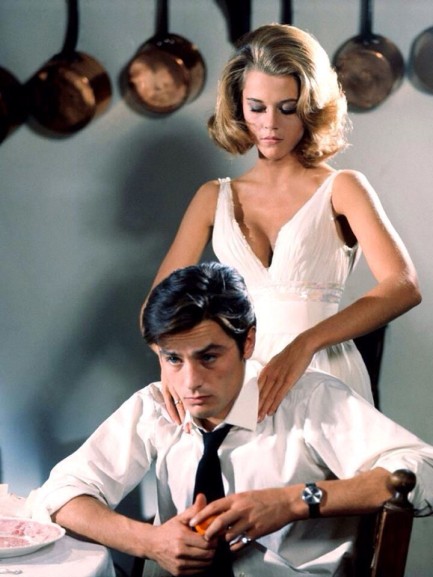 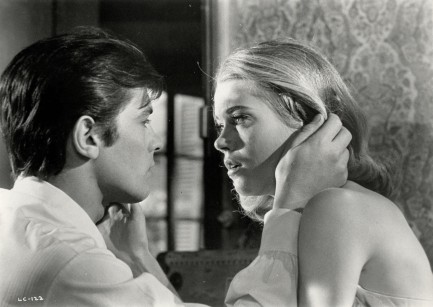 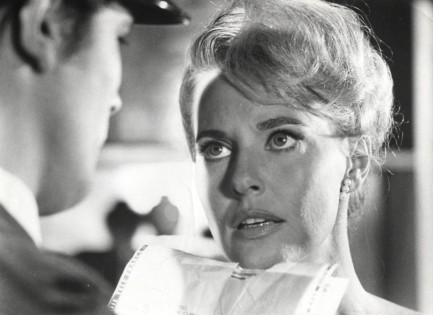 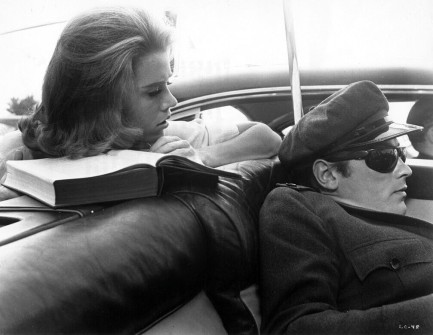 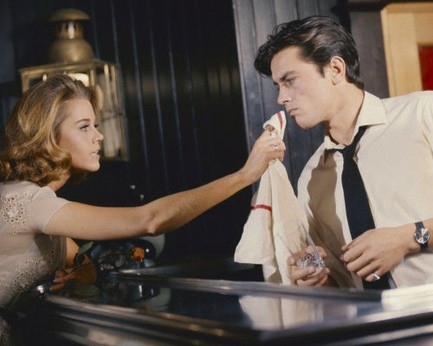 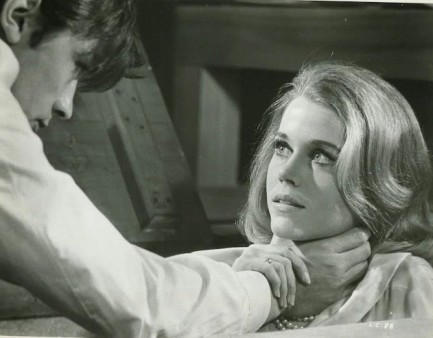 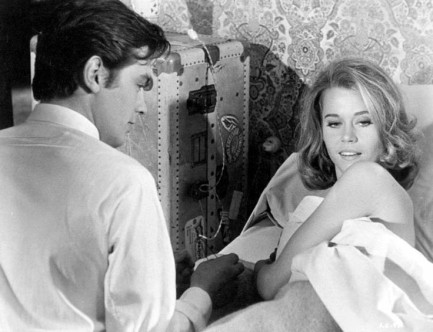 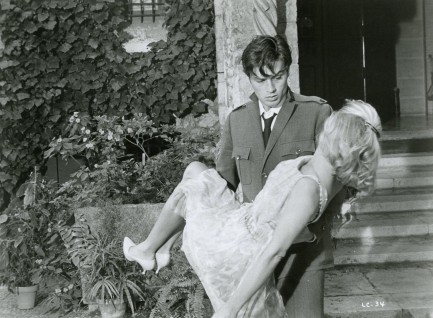 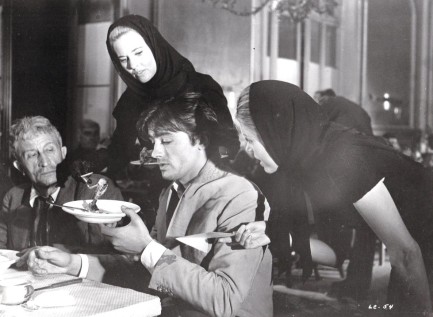 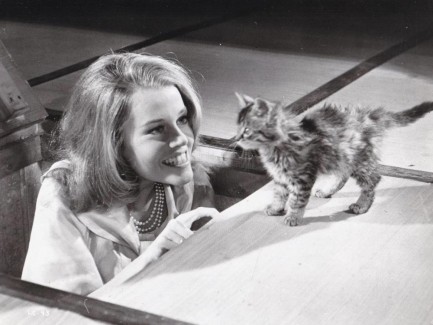 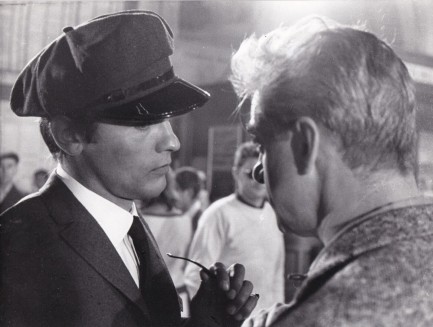 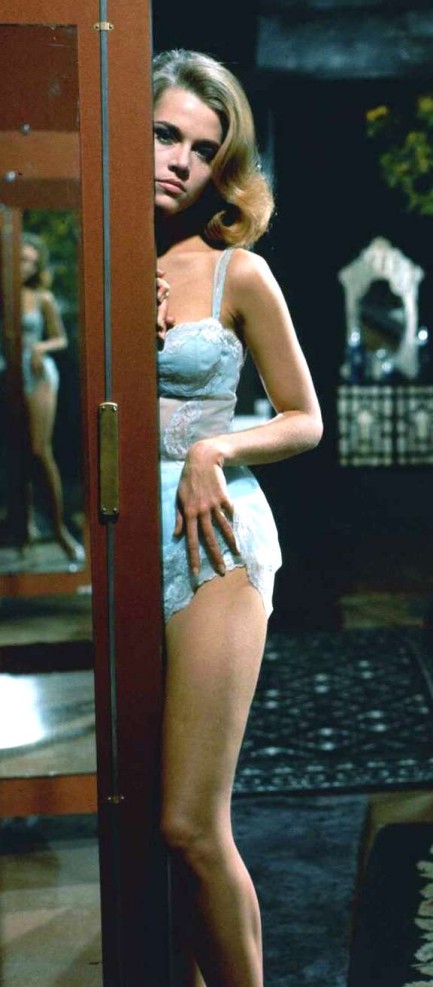 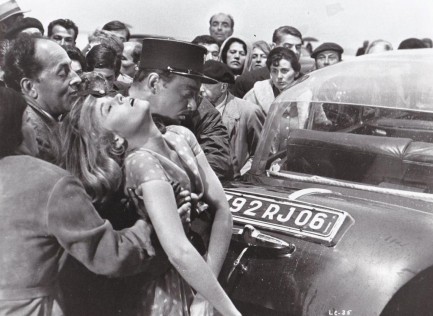 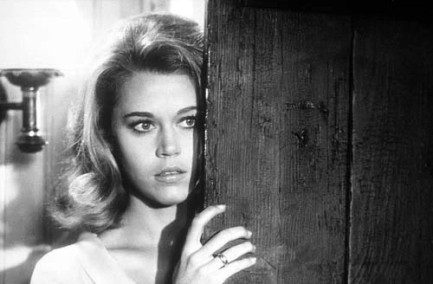 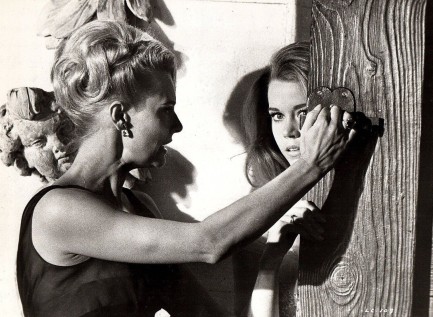 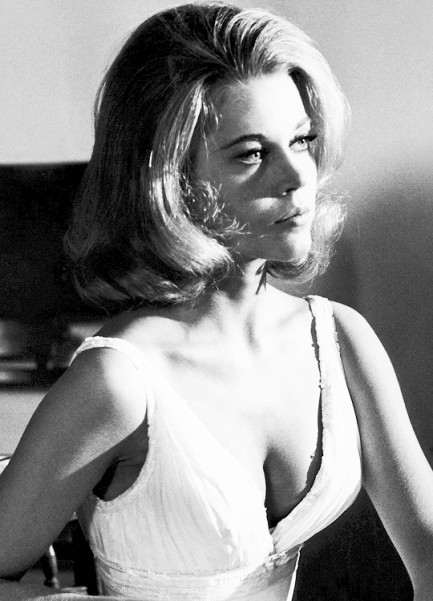
 Strindberg, Tamburi, Bisera and company wip it good in Italian sexploitation drama. 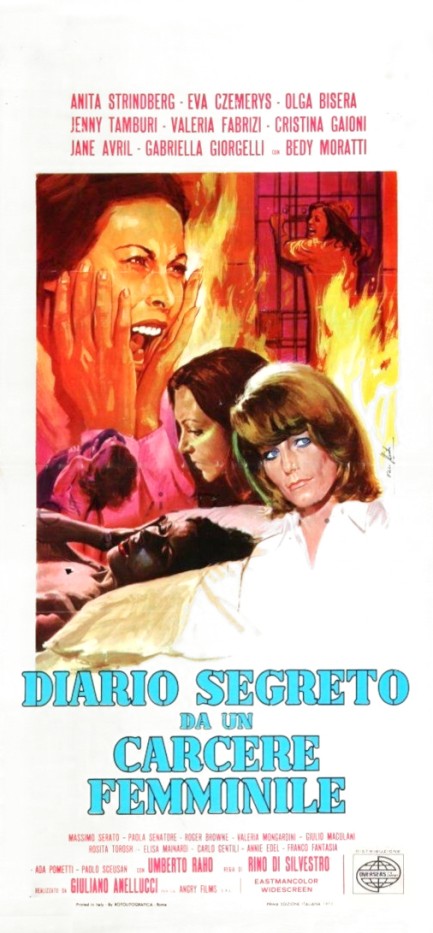
We ran across this poster for a movie we watched years ago, the exploitation drama Diario segreto da un carcere femminile, which premiered in Italy today in 1973 and is known in English as Women in Cell Block 7. Such films, for the uninitiated, are thought of by b-movie fans as belonging to a sub-genre known as women-in-prison or WiP. In honor of today's post we've gone back through the website and keyworded for them, so you can see what we've done on this unusual style of cinema by clicking “women in prison” at bottom.
The art on the poster is by Enzo Nistri, which makes it worth a share. The movie is sort of interesting too, though perhaps not exactly good. However, we've never been able to forget Olga Bisera's naughty correctional facility finger. You can see her using it in a couple of the production photos below, and following those are some of the stars, who comprise a who's-who of 1970s European exploitation cinema: Anita Strindberg, Eva Czemerys, Jenny Tamburi, Paola Senatore, Maria Pia Luzi, Gabriella Giorgelli, Olga Bisera, and Valeria Fabrizi.
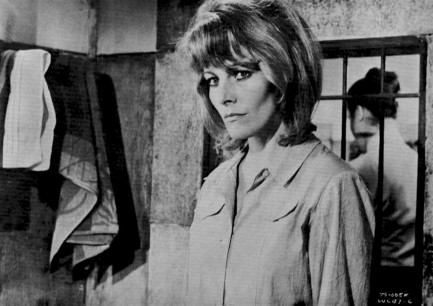 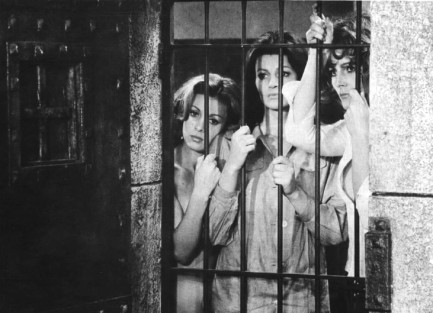 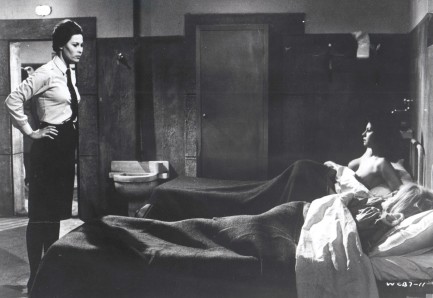 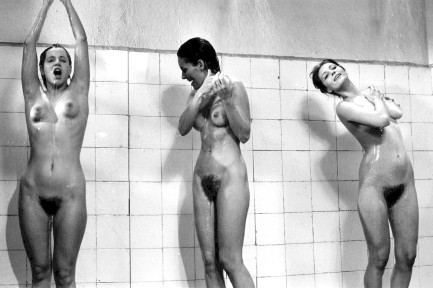 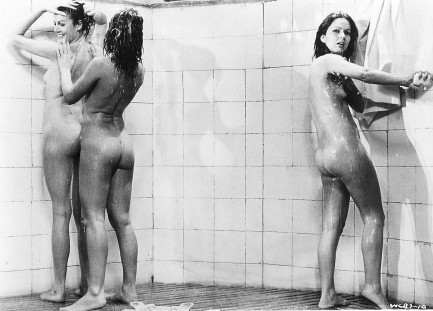 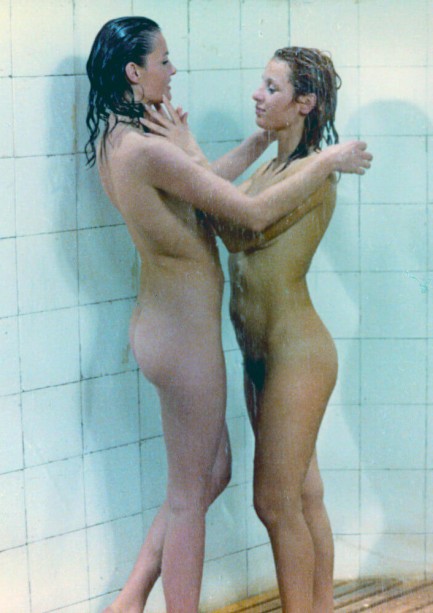 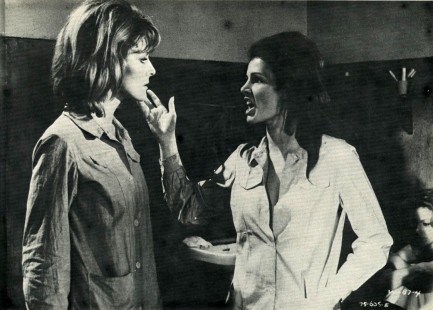 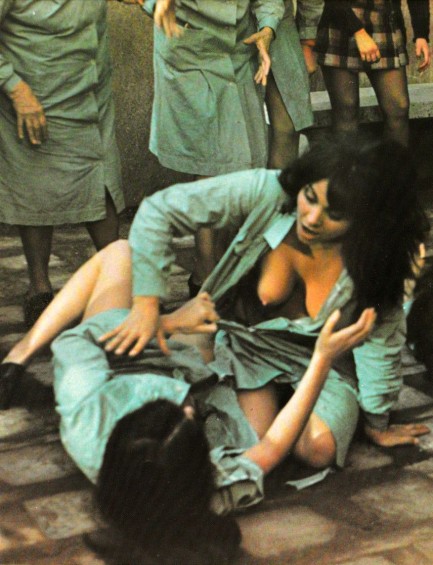 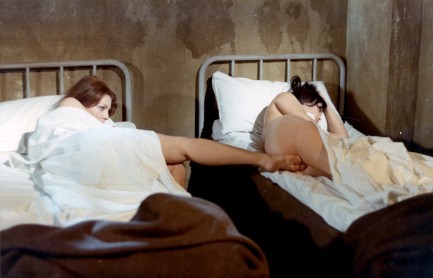 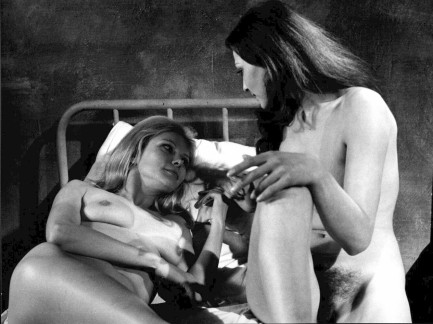 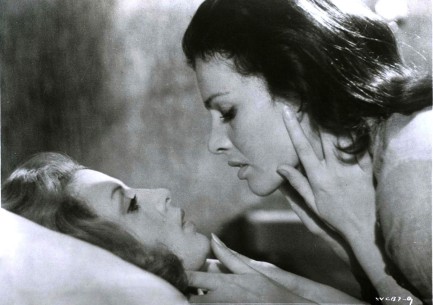 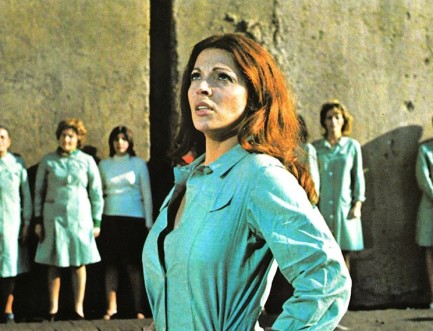 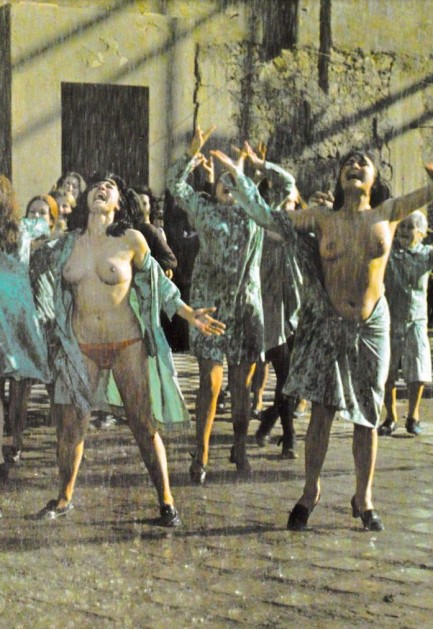 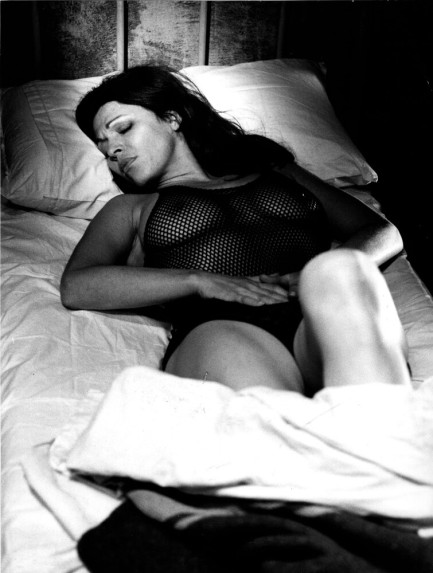 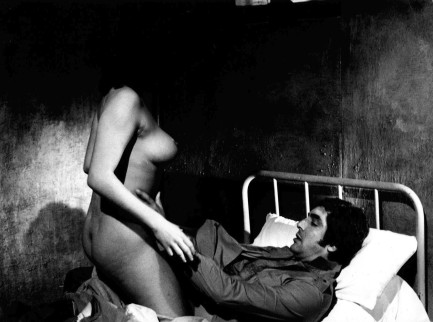 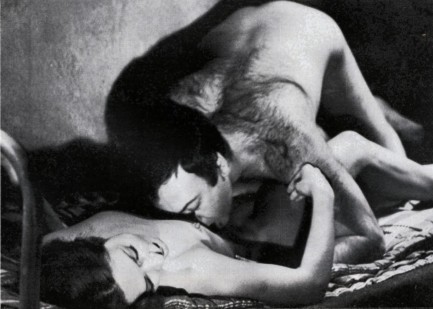 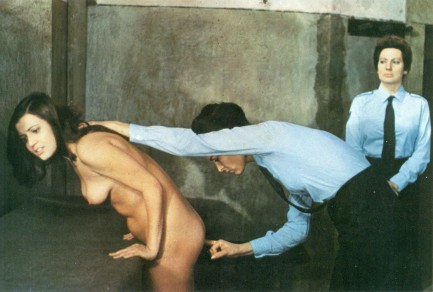 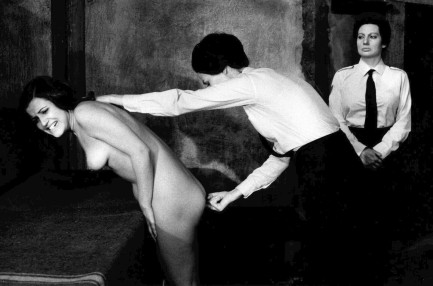   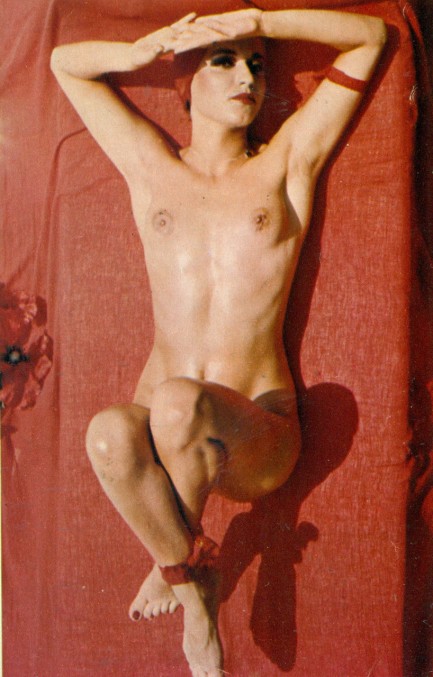 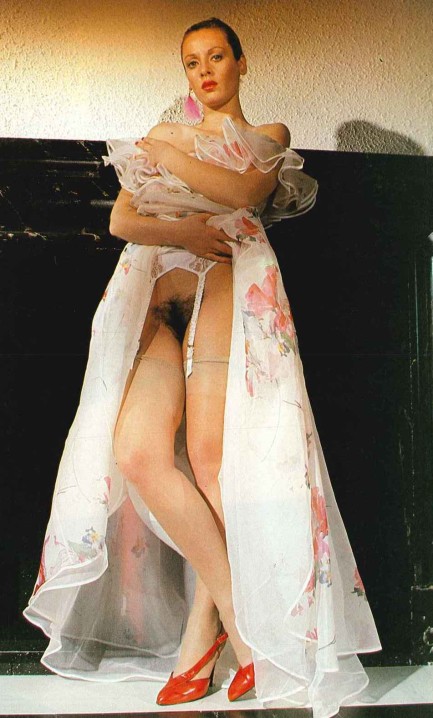 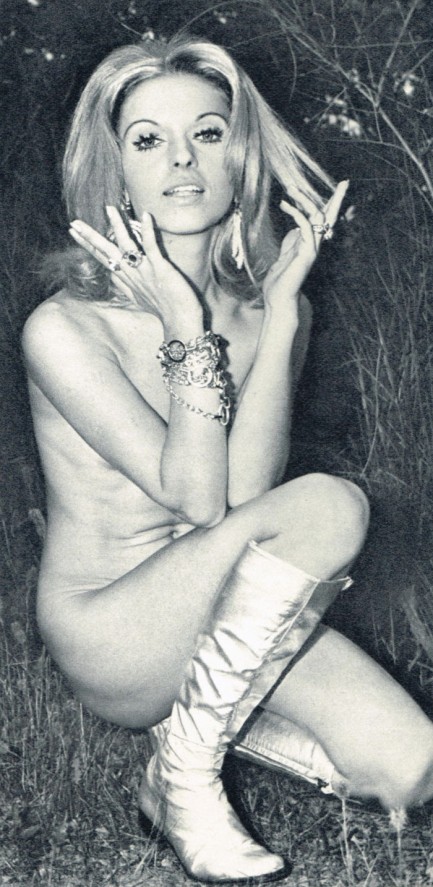 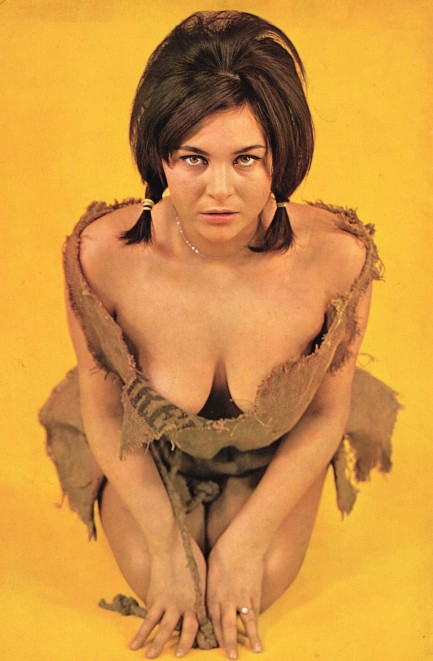 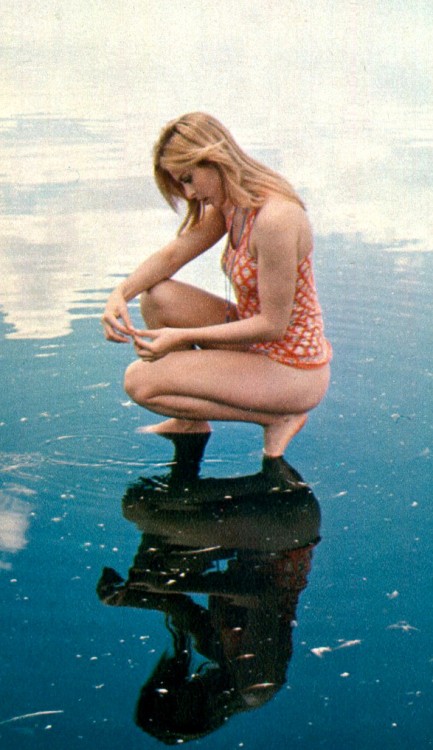
 Yul be the death of each and every one of them. 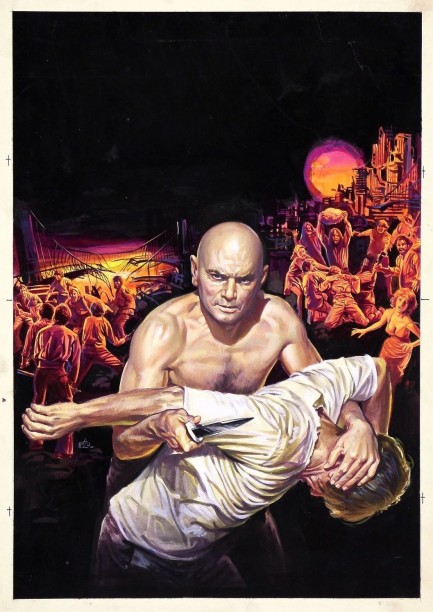
It's been quite a while since we looked at the work of Italian illustrator Enzo Nistri. In recent years we've been focusing on his younger brother Giuliano, but they were both major talents. Here you see something special from Enzo—a textless original piece of art for the 1975 Yul Brenner movie The Ultimate Warrior, known in Italian as Gli avventurieri del pianeta Terra. It's about a group of people trying to survive in post-apocalyptic New York City. They eventually hire a tough-as-nails warrior to protect them. That would be Brenner. The movie is set in 2012, which is rather funny, but sci-fi fans are used to temporal predictions being way off. Blade Runner was set in 2019, and Soylent Green was set in 2022, and here we are without flying cars, replicants, or crackers made of human beings—although that last might show up soon the way things are going. In any case, fantastic work from Enzo. We'll try to feature him more later. And we may even screen the movie and report back.
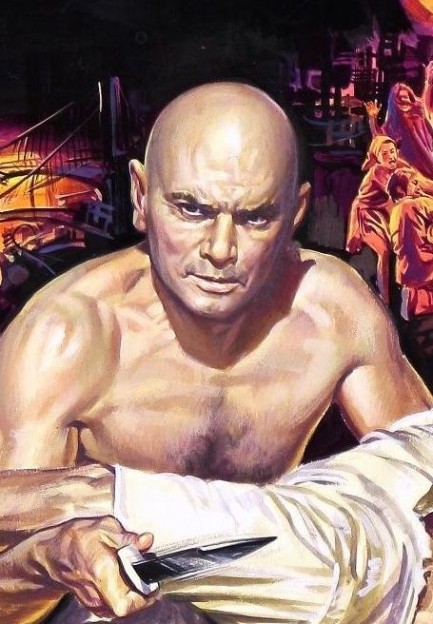
 Welch makes world's most unwieldy laundry technique look like a good idea. 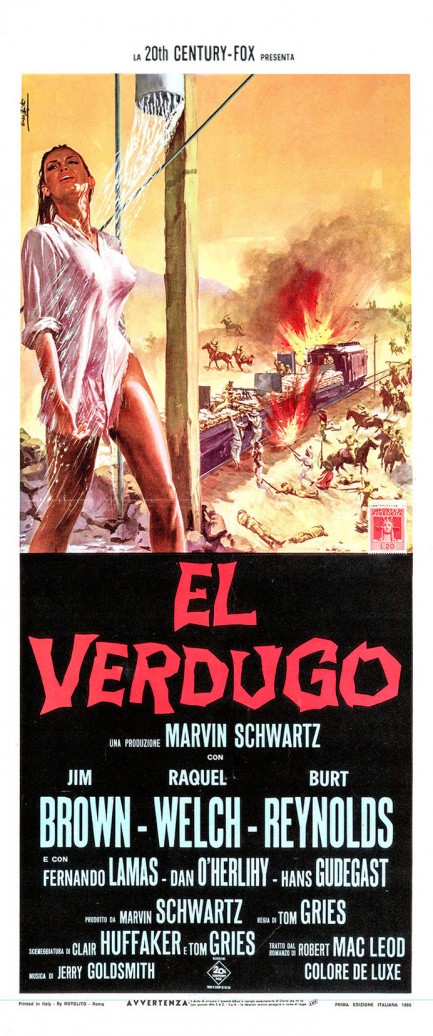
This piece of art has two things going for it—it was painted by Italian genius Enzo Nistri, and his painting is of Raquel Welch. We know—we had you already at Enzo. Consider Welch a bonus. El Verdugo is Spanish for “the executioner,” and this is a Spanish poster, despite the artist being Italian. The film is better known as 100 Rifles, a 1969 western about a revolutionary who knocks off a bank to fund the purchase of guns. It's counterculture all the way—Burt Reynolds plays a half-Native American named Yaqui Joe, Jim Brown co-stars as a lawman sent to recover the cash, Welch is also supposed to be Indian, and the subtext of revolution was meant to mirror the social unrest in the U.S. We wrote about it in detail here.
Welch takes a shower in the middle of the film, and you see below we have some promo images of that. A clothed shower? It's silly. Welch did not do nudity*, so the filmmakers should have simply left the scene out. Within the script the shower is an ambush so she can get some Mexican soldiers' guards down then ventilate them, but just set up the ambush a different way. Don't know about you, but if we came across someone showering clothed, whatever the circumstances, we'd immediately start looking over our shoulders because it's strange. That said, the photos are fun. They show what a huge sex symbol Welch was. Douse her with water and men got hot and bothered seeing hardly any skin at all. El Verdugo opened in Spain today in 1969.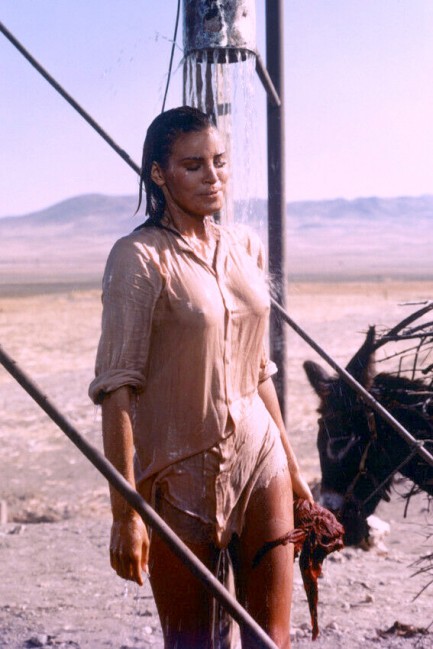 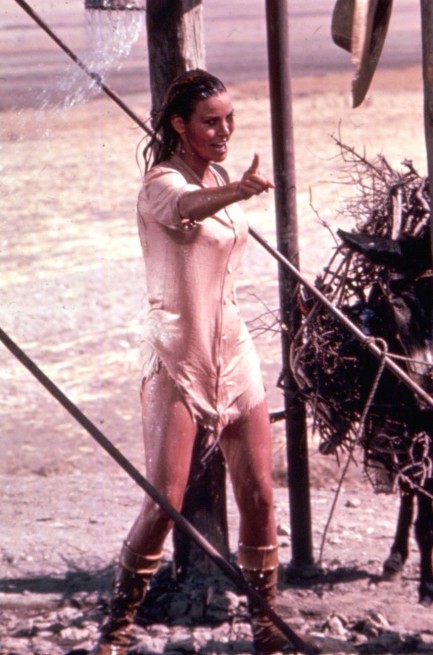 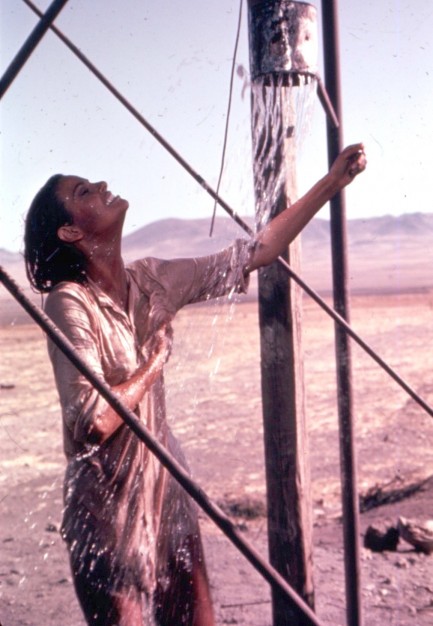 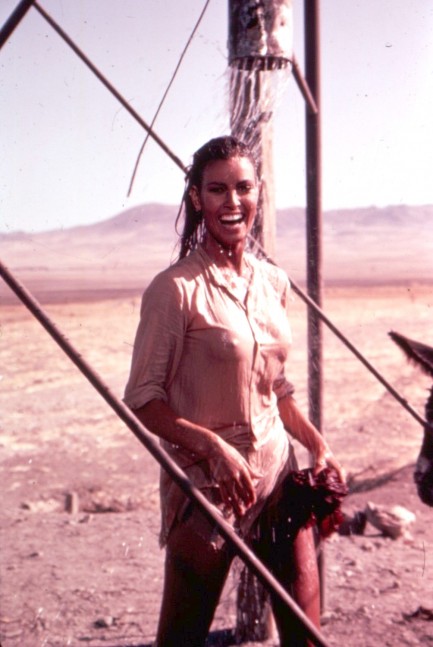 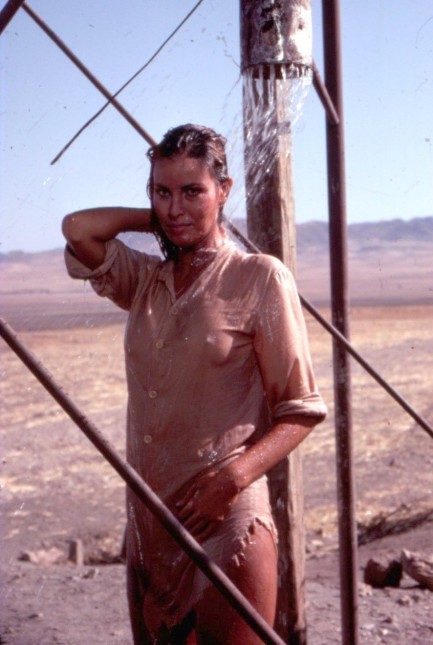 *Regarding Welch nude scenes, there's a nude photo of a woman who resembles Welch and is believed by some to have been taken on a movie set. It's plausible in the sense that back then actors got naked for scenes that were nude in scripts but not meant to be shown nude or fully nude onscreen—such as here and here—but we doubt Welch did it.
 And they thought cellblocks 1 through 6 were bad. 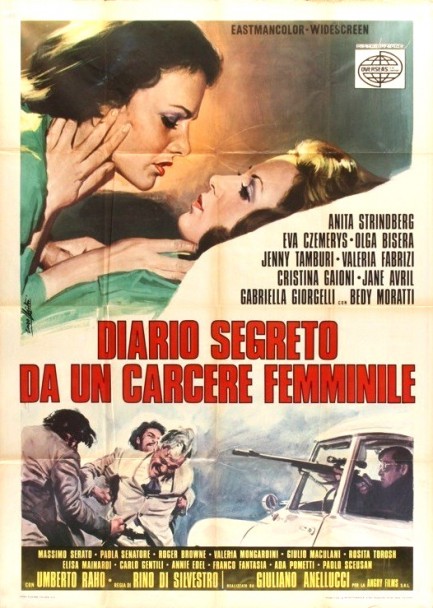
Diario segreto da un carcere femminile, for which you see a nice poster above, was released in English as Women in Cellblock 7. Jenny Tamburi is thrown in prison as an accessory to a drug trafficking doublecross that led to the disappearance of twenty kilos of heroin. Interpol agent Anita Strindberg wants to prove her father, also an Interpol agent, had nothing to do with the heist, and has herself and her amazing hair placed in prison in order to ply Tamburi for exonerating evidence. Outside parties think Tamburi knows where the missing heroin is, including her lawyer and the mafia, but she claims to have no idea.
So you have an innocent woman in prison, under threat from convicts connected to the mafia, and into this arrives an undercover agent who soon becomes her protector. The cast, which besides Tamburi and Strindberg includes Eva Czemerys, Olga Bisera, Cristina Gaioni, and Valeria Fabrizi, get to rubbing on each other in beds and showers in cinematic approximations of lesbian sex, which means you've got yourself a classic women in prison sexploitation flick. There's also a plot thread external to the prison involving the mafia trafficantes, and some of this features effective action, but it's the ladies on lockdown that are the draw here.
Do they make the movie worth watching? We wouldn't go that far, but they're certainly scenic, and they work hard to hold together a ridiculous script. The conundrum of movie acting is that you have to give it your all or be judged unfit for further roles. At eighty-one minutes in length, at least the film lets the cast out early for good behavior even if the warden doesn't. Diario segreto da un carcere femminile premiered in Italy today in 1973, and the poster was painted by Enzo Nistri. You can see more of his work here and here.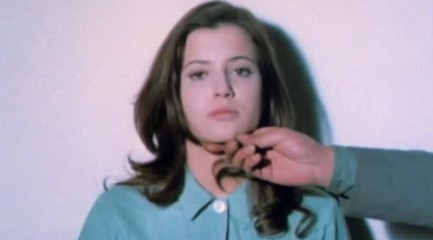 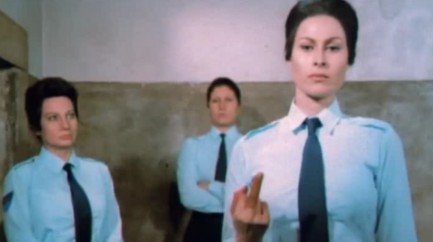 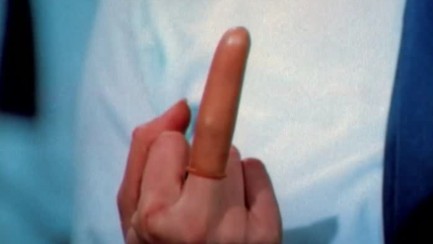 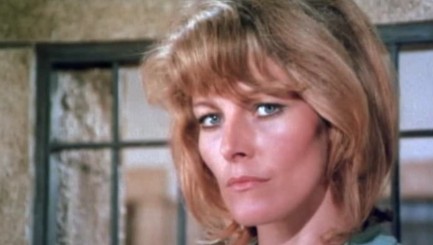
 Vice and virtue in Vienna. 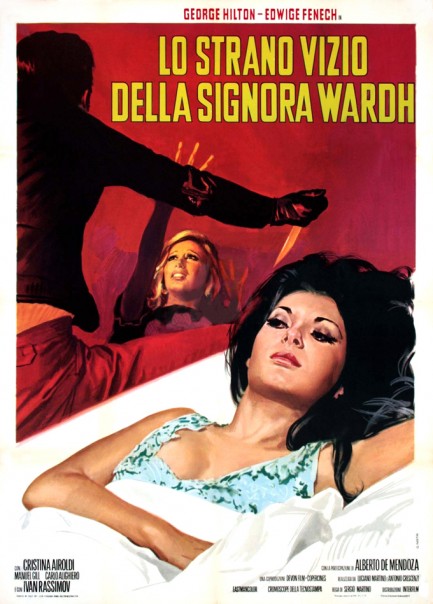
So, quite by coincidence there’s another movie we watched recently that also premiered today, though thirty years later than The Shanghai Gesture (see below). The movie is Lo strano vizio della Signora Wardh, which would translate as “The Strange Vice of Mrs. Wardh,” but was released in the U.S. as Blade of the Ripper. This flick is considered one of the best gialli ever made, and it’s tough to argue the point. It’s intricate, absorbing, unpredictable, colorful, and shot in an array of amazing external locations and inside one of the greatest mid-century modern apartments ever conceived. It also has Edwige Fenech, whose gifts are well known. Taking place mainly in Vienna and climaxing in Sitges, Spain (which happens to be one of our favorite towns in Europe)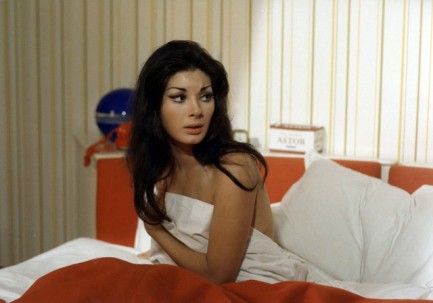 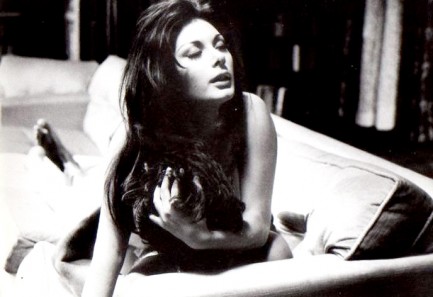 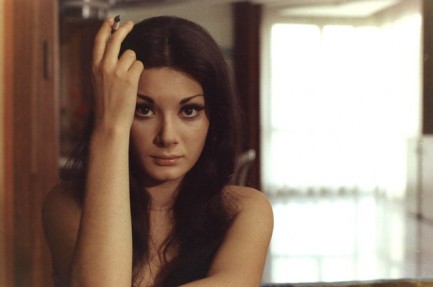 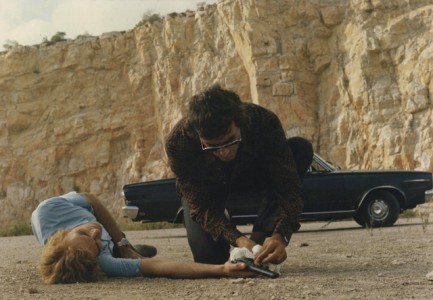 Signora Wardh is a tale of obssession and infidelity wrapped in a murder mystery. Mrs. Wardh does indeed have a strange vice, but that’s just window dressing. It’s her that’s being hunted throughout the movie—either by a serial killer, a demented ex-lover, or both. Or neither. They say that the only way to keep a secret is if no more than two people know it and one of them is dead. But the only way to commit murder is if the killer has an iron clad alibi, and for that he often needs help. Rule one conflicts with rule two, and that’s the fun of Signora Wardh. Above you see a rare and wonderful Italian promo poster painted by Giuliano Nistri, the younger brother of equally talented Enzo Nistri. We'll get back to both Nistri brothers a little later. Lo strano vizio della Signora Wardh opened in Italy today in 1971. Signora Wardh is a tale of obssession and infidelity wrapped in a murder mystery. Mrs. Wardh does indeed have a strange vice, but that’s just window dressing. It’s her that’s being hunted throughout the movie—either by a serial killer, a demented ex-lover, or both. Or neither. They say that the only way to keep a secret is if no more than two people know it and one of them is dead. But the only way to commit murder is if the killer has an iron clad alibi, and for that he often needs help. Rule one conflicts with rule two, and that’s the fun of Signora Wardh. Above you see a rare and wonderful Italian promo poster painted by Giuliano Nistri, the younger brother of equally talented Enzo Nistri. We'll get back to both Nistri brothers a little later. Lo strano vizio della Signora Wardh opened in Italy today in 1971.
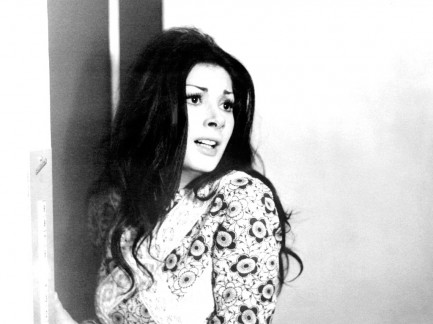 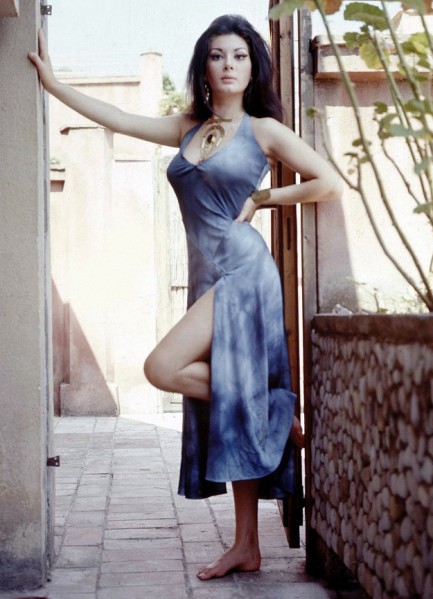
 The movie isn’t perfect, but the Japanese promo poster is. 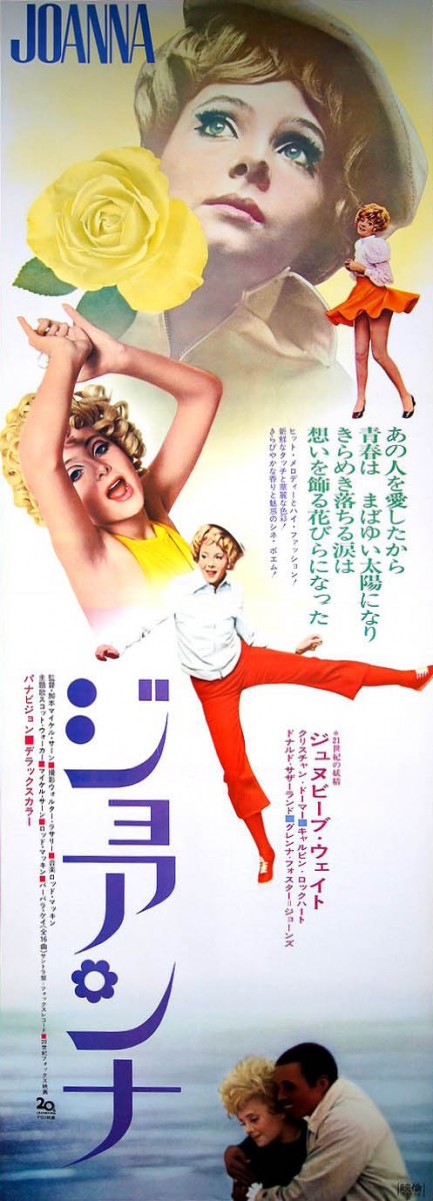
Something a bit different today. We saw this poster and loved its colors and vibrancy. It’s for the 1968 counterculture movie Joanna, which was about a young woman in swinging 1960s London. Think of it as a distaff version of Alfie, but with the added taboo of interracial romance. The star is Geneviève Waïte, and Donald Sutherland also puts in an appearance. Like a lot of movies that tried to capture the spirit of the ’60s, Joanna has not aged particularly well, but it’s beloved by many who were in high school or college when it came out. The movie is well before our time, but we liked it anyway. It isn’t perfect, but it has some really great moments, including an interlude in Morocco. As a bonus, we’ve posted the English, Spanish and Italian promos below. You’ll note that the Italian version was painted by Enzo Nistri. He did quite a bit of nice work in the ’60s and ’70s. We’ll get back to him. 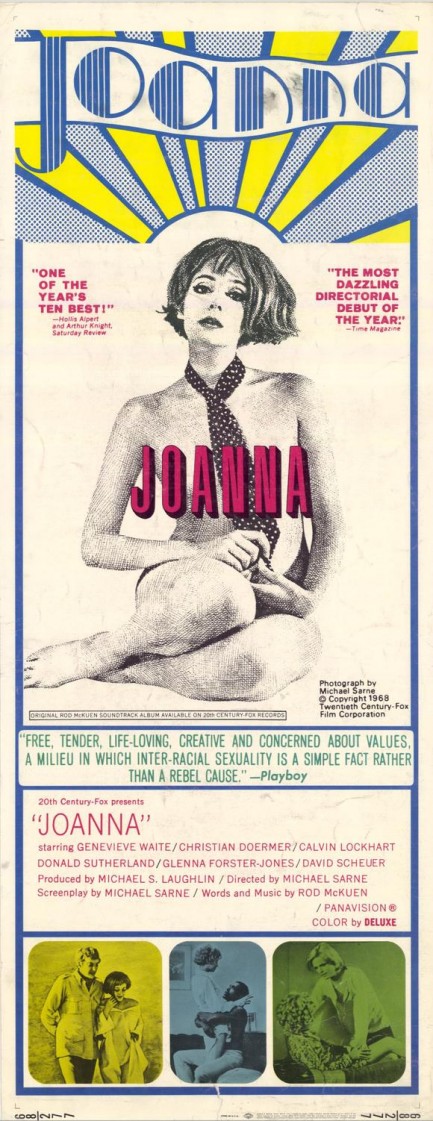 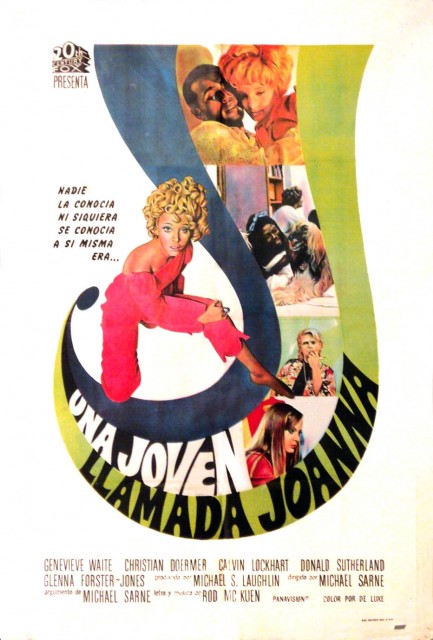 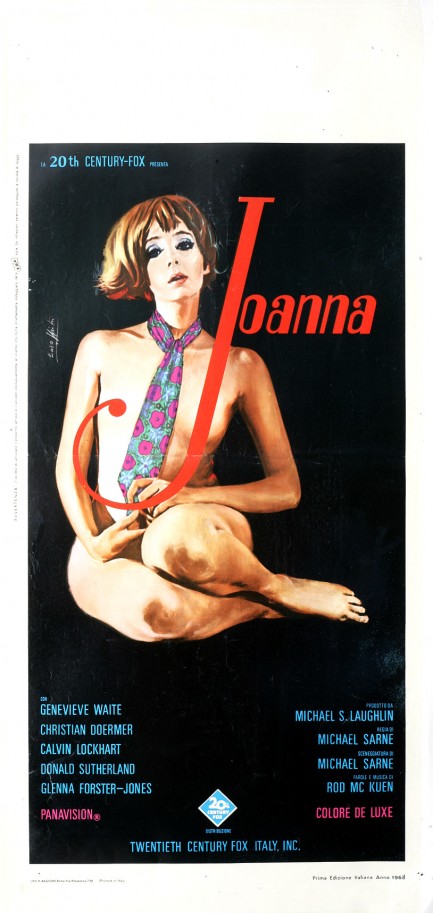
|
 |

The headlines that mattered yesteryear.
2003—Hope Dies
Film legend Bob Hope dies of pneumonia two months after celebrating his 100th birthday. 1945—Churchill Given the Sack
In spite of admiring Winston Churchill as a great wartime leader, Britons elect
Clement Attlee the nation's new prime minister in a sweeping victory for the Labour Party over the Conservatives. 1952—Evita Peron Dies
Eva Duarte de Peron, aka Evita, wife of the president of the Argentine Republic, dies from cancer at age 33. Evita had brought the working classes into a position of political power never witnessed before, but was hated by the nation's powerful military class. She is lain to rest in Milan, Italy in a secret grave under a nun's name, but is eventually returned to Argentina for reburial beside her husband in 1974. 1943—Mussolini Calls It Quits
Italian dictator Benito Mussolini steps down as head of the armed forces and the government. It soon becomes clear that Il Duce did not relinquish power voluntarily, but was forced to resign after former Fascist colleagues turned against him. He is later installed by Germany as leader of the Italian Social Republic in the north of the country, but is killed by partisans in 1945.
|

|
|

It's easy. We have an uploader that makes it a snap. Use it to submit your art, text, header, and subhead. Your post can be funny, serious, or anything in between, as long as it's vintage pulp. You'll get a byline and experience the fleeting pride of free authorship. We'll edit your post for typos, but the rest is up to you. Click here to give us your best shot.

|
|


























 role as Albright's cousin and household helper. The two are soon in competition for Delon's affections, though he never forgets that his main goal is to escape the mobsters. While the general thrust of the plot remains a mystery as in Keene's novel, there's a heavy dose of action too, with excellent stunts. The ending differs as well.
role as Albright's cousin and household helper. The two are soon in competition for Delon's affections, though he never forgets that his main goal is to escape the mobsters. While the general thrust of the plot remains a mystery as in Keene's novel, there's a heavy dose of action too, with excellent stunts. The ending differs as well.





































































 Signora Wardh is a tale of obssession and infidelity wrapped in a murder mystery. Mrs. Wardh does indeed have a strange vice, but that’s just window dressing. It’s her that’s being hunted throughout the movie—either by a serial killer, a demented ex-lover, or both. Or neither. They say that the only way to keep a secret is if no more than two people know it and one of them is dead. But the only way to commit murder is if the killer has an iron clad alibi, and for that he often needs help. Rule one conflicts with rule two, and that’s the fun of Signora Wardh. Above you see a rare and wonderful Italian promo poster painted by Giuliano Nistri, the younger brother of equally talented Enzo Nistri. We'll get back to both Nistri brothers a little later. Lo strano vizio della Signora Wardh opened in Italy today in 1971.
Signora Wardh is a tale of obssession and infidelity wrapped in a murder mystery. Mrs. Wardh does indeed have a strange vice, but that’s just window dressing. It’s her that’s being hunted throughout the movie—either by a serial killer, a demented ex-lover, or both. Or neither. They say that the only way to keep a secret is if no more than two people know it and one of them is dead. But the only way to commit murder is if the killer has an iron clad alibi, and for that he often needs help. Rule one conflicts with rule two, and that’s the fun of Signora Wardh. Above you see a rare and wonderful Italian promo poster painted by Giuliano Nistri, the younger brother of equally talented Enzo Nistri. We'll get back to both Nistri brothers a little later. Lo strano vizio della Signora Wardh opened in Italy today in 1971. 










































































